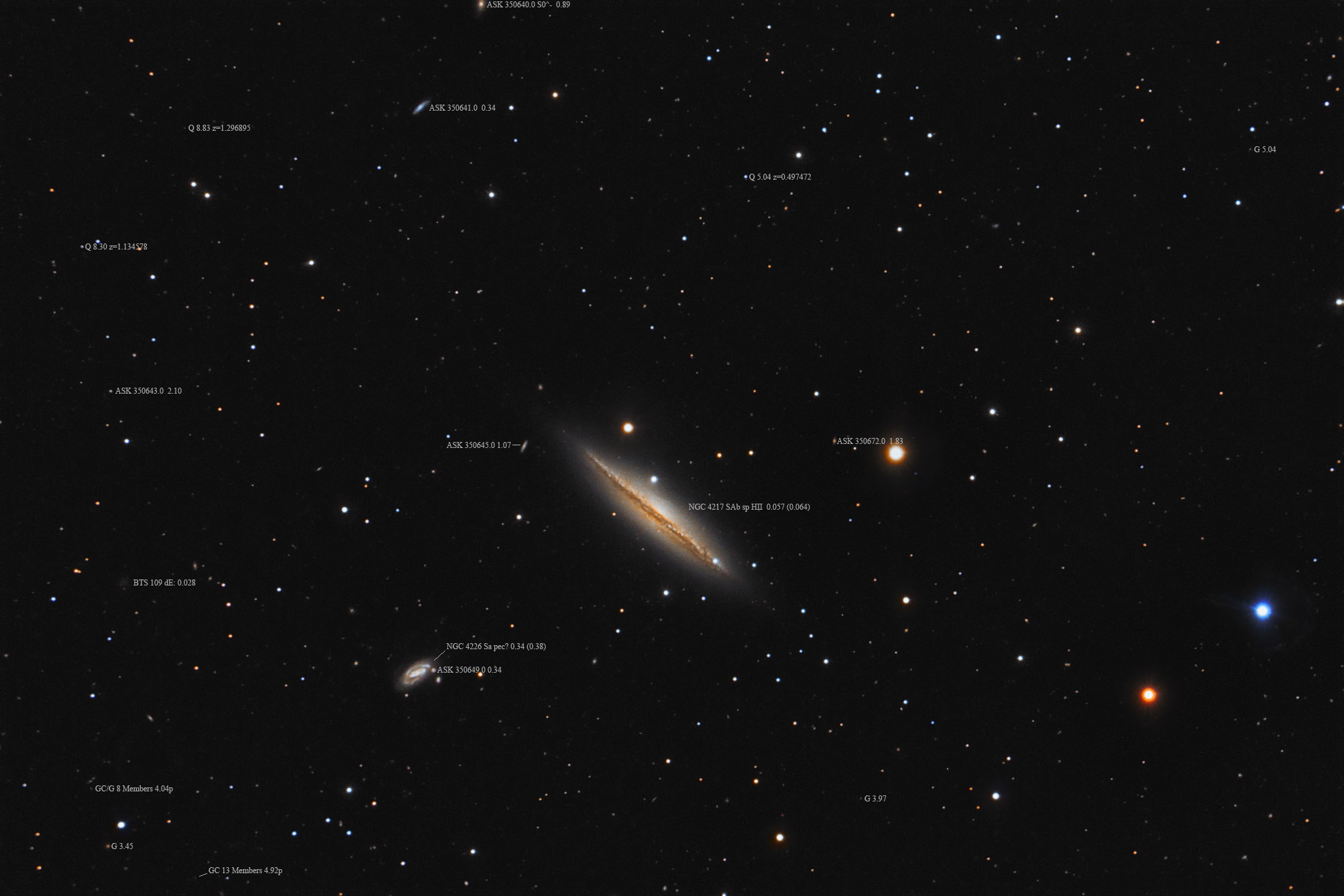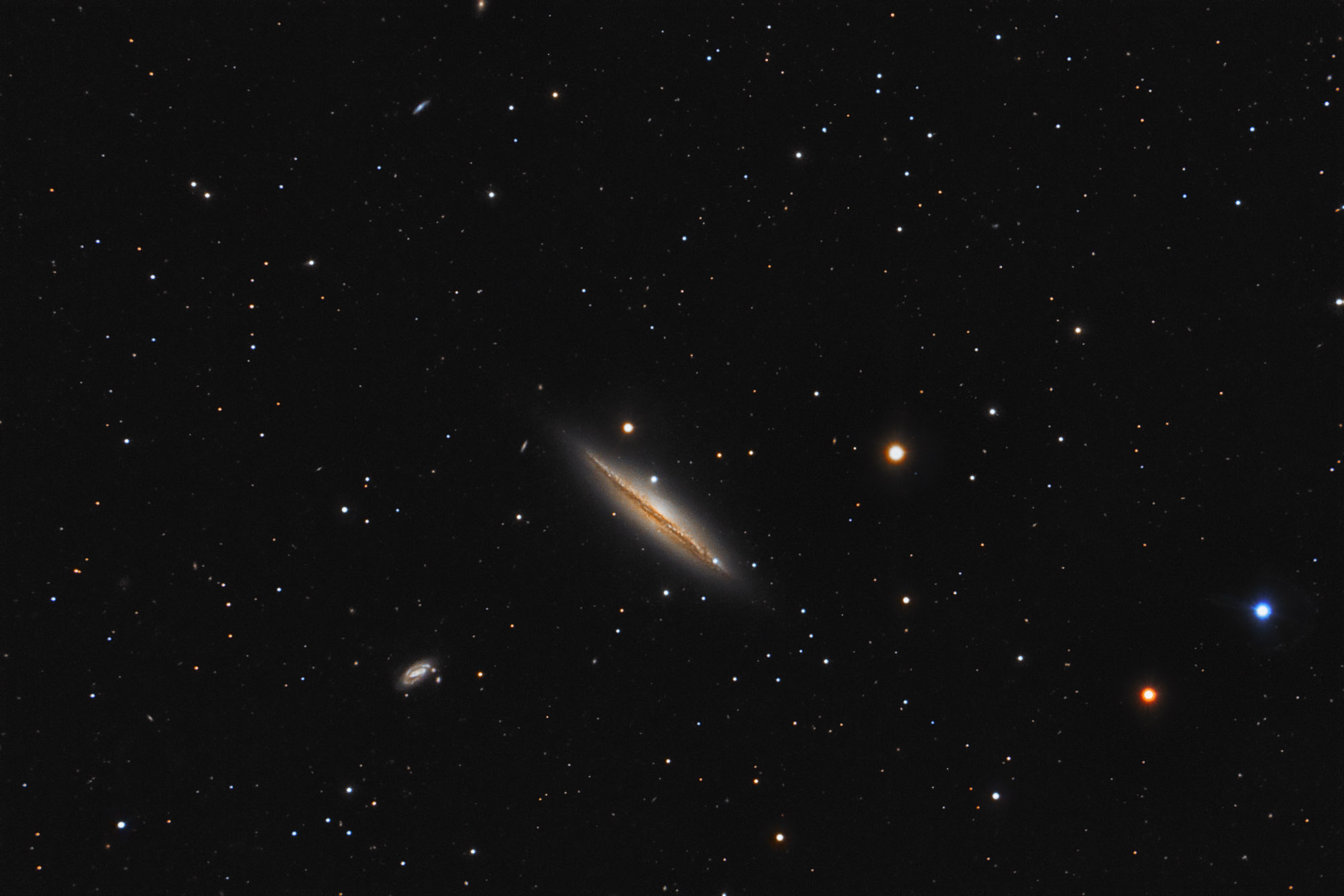| Description | Images |
Object name: NGC4217Designation(s): NGC4217, NGC4226, NGC 4217 is an edge on galaxy often seen in wide field shots of M 106 but deserving of being imaged for itself though this is rarely done for some reason. It is classified at NED as SAb with HII emission. I didn't bring out any of these in the RGB image. At first glance, I thought it looked a bit twisted as there's more to see on the west side than the eastern half. But I think this is due to a spiral arm coming around toward us on the western side that is going away from us on the eastern side. Thus the eastern one is mostly hidden by the galaxy itself. But there may be a twist as well. The galaxy was discovered by William Herschel on April 10, 1788. It is in Canes Venatici and about 57 million light-years distant by redshift at 64 million distant by a couple of Tully Fisher measurements. Since it may be a member of the Virgo cluster I'll sort of average the two and call it 60 million light-years. That puts its faint outer reaches at some 125,000 light-years across. Likely its stars extend much further as there's really no edge to a galaxy, the stars just get less and less dense without any clear end. Using the brighter portion it is about 100,000 light-years across. While imaged with M 106 it is nearly 3 times more distant than its famous neighbor so they are not related, just they share about the same line of sight as seen from earth It is in the Herschel 2 observing program but not one I've logged visually for some reason. The nearby bright stars do make this one a bear to process as they sent lots of light flying around. Related Designation(s):2MASS J12162628+4701314, 2MASX J12155089+4705304, 2MASX J12162629+4701310, 2MASXi J1215508+470535, 2MASXi J1216263+470131, 2MFGC 09661, 6C B121319.0+472144, 87GB 121321.3+472200, 87GB[BWE91] 1213+4721, AKARI J1215502+470527, AKARI J1216257+470132, B3 1213+473, CGCG 1213.3+4721, CGCG 1214.0+4717, CGCG 243-053, CGCG 243-057, CXO J121626.2+470130, ECO 03471, GALEXMSC J121626.01+470132.5 , GB6 J1215+4705, HDCE 0703 NED004, HDCE 0706 NED050, HIJASS J1215+47, HOLM 354A, HOLM 354B, IRAS F12133+4722, IRAS F12139+4718, ISOSS J12158+4705, KHG 1-C04, LDCE 0867 NED092, LDCE 0877 NED004, LGG 258:[G93] 026, MAPS-NGP O_171_0165227, MCG +08-22-087, MCG +08-22-090, NGC 4217, NGC 4226, NGC4217, NGC4226, NSA 141005, NSA 141027, NVSS J121550+470526, NVSS J121626+470132, PGC 039241, PGC 039312, SDSS J121550.89+470530.4, SDSS J121626.29+470131.5, SDSS J121626.29+470131.6, SSTSL2 J121626.29+470131.0, UGC 07282, UGC 07297, UMa Cluster:[PRL2014] U151, USGC U477 NED05, USGC U480 NED27, UZC J121551.4+470529, UZC J121626.3+470132, [H92] 23, [M98j] 165 NED01, [M98j] 170 NED48, [SLK2004] 0676, [WB92] 1213+4721, | Permanent link: https://images.mantrapskies.com/catalog/NGC/NGC4217-NGC4226/NGC4217L4X10RG1X10B2X10ID.JPG |


